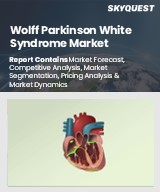
|
시장보고서
상품코드
1801967
볼프 파킨슨 화이트 증후군 시장 규모, 점유율, 성장 분석 : 유형별, 진단별, 치료별, 최종사용자별, 지역별 - 산업 예측(2025-2032년)Wolff Parkinson White Syndrome Market Size, Share, and Growth Analysis, By Type (Type A, Type B), By Diagnosis (Electrocardiogram (ECG), Electrophysiological Testing), By Treatment, By End User, By Region - Industry Forecast 2025-2032 |
||||||
세계의 볼프 파킨슨 화이트 증후군 시장 규모는 2023년에 11억 달러로 평가되며, 예측 기간(2025-2032년)의 CAGR은 11.8%로, 2024년 12억 3,000만 달러에서 2032년에는 30억 달러로 성장할 전망입니다.
세계 볼프 파킨슨 화이트(WPW) 증후군 시장은 유병률 증가와 진단 및 치료 기술 발전에 힘입어 괄목할 만한 성장을 거듭하고 있습니다. 의료 시스템은 환자의 예후를 개선하기 위해 WPW 증후군을 포함한 부정맥의 조기 발견과 효과적인 관리를 우선시하고 있습니다. 머신러닝과 인공지능(AI) 등의 기술 혁신은 WPW의 진단과 치료의 판도를 바꾸고 있으며, 보다 정확한 위험 계층화와 관리를 가능하게 하고 있습니다. AI 기반 알고리즘은 심전도(ECG) 데이터를 분석하도록 설계되어 WPW 패턴의 조기 발견을 용이하게 하고, 부경로의 국소화를 개선합니다. 이러한 개발은 시장 개발을 촉진하고 WPW 증후군의 일련의 치료에 대한 임상 관행이 개선되고 있습니다.
목차
서론
- 조사의 목적
- 조사 범위
- 정의
조사 방법
- 정보 조달
- 2차와 1차 데이터 방법
- 시장 규모 예측
- 시장의 전제조건과 제한
개요
- 세계 시장 전망
- 공급과 수요 동향 분석
- 부문별 기회 분석
시장 역학과 전망
- 시장 개요
- 시장 규모
- 시장 역학
- 촉진요인과 기회
- 억제요인과 과제
- Porter의 산업 분석
주요 시장 인사이트
- 주요 성공 요인
- 경쟁의 정도
- 주요 투자 기회
- 시장 에코시스템
- 시장의 매력 지수(2024년)
- PESTEL 분석
- 거시경제 지표
- 밸류체인 분석
- 가격 분석
- 사례 연구
볼프 파킨슨 화이트 증후군 시장 규모 : 유형별 & CAGR(2025-2032)
- 시장 개요
- 유형 A
- 유형 B
볼프 파킨슨 화이트 증후군 시장 규모 : 진단별 & CAGR(2025-2032)
- 시장 개요
- 심전도(ECG)
- 전기생리학적 검사
- 기타
볼프 파킨슨 화이트 증후군 시장 규모 : 치료별 & CAGR(2025-2032)
- 시장 개요
- 의약품
- 카테터 절제
- 수술
볼프 파킨슨 화이트 증후군 시장 규모 : 최종사용자별 & CAGR(2025-2032)
- 시장 개요
- 병원과 진료소
- 학술 조사기관
- 기타
볼프 파킨슨 화이트 증후군 시장 규모 : 지역별 & CAGR(2025-2032)
- 북미
- 미국
- 캐나다
- 유럽
- 독일
- 스페인
- 프랑스
- 영국
- 이탈리아
- 기타 유럽 지역
- 아시아태평양
- 중국
- 인도
- 일본
- 한국
- 기타 아시아태평양
- 라틴아메리카
- 브라질
- 기타 라틴아메리카 지역
- 중동 및 아프리카
- GCC 국가
- 남아프리카공화국
- 기타 중동 및 아프리카
경쟁 정보
- 상위 5사의 비교
- 주요 기업의 시장 포지셔닝(2024년)
- 주요 시장 기업이 채택한 전략
- 최근 시장 동향
- 기업의 시장 점유율 분석(2024년)
- 주요 기업의 기업 개요
- 기업의 상세
- 제품 포트폴리오 분석
- 기업의 부문별 점유율 분석
- 매출의 전년대비 비교(2022-2024년)
주요 기업 개요
- Medtronic
- Johnson & Johnson Services, Inc.
- Japan Lifeline Co., Ltd.
- Abbott
- Boston Scientific Corporation
- BIOTRONIK SE & Co. KG
- B. Braun Melsungen AG
- Terumo Corporation
- MicroPort Scientific Corporation
- Meril Life Sciences Pvt. Ltd.
- Vascular Concepts
- W. L. Gore and Associates
- Translumina GmbH
- Endologix, Inc.
결론과 제안
KSA 25.09.05Global Wolff Parkinson White Syndrome Market size was valued at USD 1.1 billion in 2023 and is poised to grow from USD 1.23 billion in 2024 to USD 3.0 billion by 2032, growing at a CAGR of 11.8% during the forecast period (2025-2032).
The global Wolff Parkinson White (WPW) syndrome market is experiencing notable growth driven by an increasing incidence of the condition and advancements in diagnostic and therapeutic technologies. Healthcare systems are prioritizing early identification and effective management of cardiac arrhythmias, including WPW Syndrome, to enhance patient outcomes. Innovations such as machine learning and artificial intelligence (AI) are revolutionizing the landscape of WPW diagnosis and treatment, enabling more precise risk stratification and management. AI-driven algorithms are being designed to analyze electrocardiogram (ECG) data, facilitating the early detection of WPW patterns and improving the localization of accessory pathways. Together, these developments are propelling market expansion and improving clinical practices within the WPW Syndrome care continuum.
Top-down and bottom-up approaches were used to estimate and validate the size of the Global Wolff Parkinson White Syndrome market and to estimate the size of various other dependent submarkets. The research methodology used to estimate the market size includes the following details: The key players in the market were identified through secondary research, and their market shares in the respective regions were determined through primary and secondary research. This entire procedure includes the study of the annual and financial reports of the top market players and extensive interviews for key insights from industry leaders such as CEOs, VPs, directors, and marketing executives. All percentage shares split, and breakdowns were determined using secondary sources and verified through Primary sources. All possible parameters that affect the markets covered in this research study have been accounted for, viewed in extensive detail, verified through primary research, and analyzed to get the final quantitative and qualitative data.
Global Wolff Parkinson White Syndrome Market Segments Analysis
Global Wolff Parkinson White Syndrome Market is segmented by Type, Diagnosis, Treatment, End User and region. Based on Type, the market is segmented into Type A and Type B. Based on Diagnosis, the market is segmented into Electrocardiogram (ECG), Electrophysiological Testing and Others. Based on Treatment, the market is segmented into Medications, Catheter Ablation and Surgery. Based on End User, the market is segmented into Hospitals and Clinics, Academic and Research Institutions and Others. Based on region, the market is segmented into North America, Europe, Asia Pacific, Latin America and Middle East & Africa.
Driver of the Global Wolff Parkinson White Syndrome Market
The global market for Wolff-Parkinson-White Syndrome is experiencing growth primarily due to the rising inclination towards catheter ablation as a treatment option compared to traditional surgical methods. Healthcare facilities are increasingly adopting these advanced technologies due to their superior success rates, reduced recovery times, and minimized complications. Additionally, innovations in robotic assistance and real-time mapping are enhancing the precision of ablation procedures, further driving their adoption across both developed and developing regions. As these factors contribute to improved patient outcomes, they are significantly influencing the expansion of the market for WPW treatments worldwide.
Restraints in the Global Wolff Parkinson White Syndrome Market
The Wolff-Parkinson-White Syndrome market faces significant challenges due to the high costs associated with electrophysiological testing and catheter ablation procedures, particularly in low- and middle-income regions. In developing countries, the lack of reimbursement policies exacerbates this issue, limiting patient access to necessary treatments. Despite advancements in technology, the disparities in affordability persist, impeding the broad adoption of innovative therapies for WPW. This situation not only affects the market dynamics but also has a considerable impact on the overall accessibility and equity of healthcare delivery for patients suffering from this condition.
Market Trends of the Global Wolff Parkinson White Syndrome Market
The Global Wolff Parkinson White Syndrome market is witnessing a notable trend towards the integration of artificial intelligence (AI) for early diagnosis. AI-powered ECG analysis tools enhance the detection of pre-excitation patterns, facilitating timelier interventions and improved patient outcomes. This technological advancement is particularly impactful in both urban and rural settings, as healthcare facilities increasingly adopt smart cardiac monitoring devices. Such innovations reduce the dependency on in-person consultations, thereby streamlining patient management pathways. As AI continues to evolve within cardiology, its role in transforming diagnostic processes and enhancing care accessibility is expected to drive significant growth in the Wolff Parkinson White Syndrome market.
Table of Contents
Introduction
- Objectives of the Study
- Scope of the Report
- Definitions
Research Methodology
- Information Procurement
- Secondary & Primary Data Methods
- Market Size Estimation
- Market Assumptions & Limitations
Executive Summary
- Global Market Outlook
- Supply & Demand Trend Analysis
- Segmental Opportunity Analysis
Market Dynamics & Outlook
- Market Overview
- Market Size
- Market Dynamics
- Drivers & Opportunities
- Restraints & Challenges
- Porters Analysis
- Competitive rivalry
- Threat of substitute
- Bargaining power of buyers
- Threat of new entrants
- Bargaining power of suppliers
Key Market Insights
- Key Success Factors
- Degree of Competition
- Top Investment Pockets
- Market Ecosystem
- Market Attractiveness Index, 2024
- PESTEL Analysis
- Macro-Economic Indicators
- Value Chain Analysis
- Pricing Analysis
- Case Studies
Global Wolff Parkinson White Syndrome Market Size by Type & CAGR (2025-2032)
- Market Overview
- Type A
- Type B
Global Wolff Parkinson White Syndrome Market Size by Diagnosis & CAGR (2025-2032)
- Market Overview
- Electrocardiogram (ECG)
- Electrophysiological Testing
- Others
Global Wolff Parkinson White Syndrome Market Size by Treatment & CAGR (2025-2032)
- Market Overview
- Medications
- Catheter Ablation
- Surgery
Global Wolff Parkinson White Syndrome Market Size by End User & CAGR (2025-2032)
- Market Overview
- Hospitals and Clinics
- Academic and Research Institutions
- Others
Global Wolff Parkinson White Syndrome Market Size & CAGR (2025-2032)
- North America (Type, Diagnosis, Treatment, End User)
- US
- Canada
- Europe (Type, Diagnosis, Treatment, End User)
- Germany
- Spain
- France
- UK
- Italy
- Rest of Europe
- Asia Pacific (Type, Diagnosis, Treatment, End User)
- China
- India
- Japan
- South Korea
- Rest of Asia-Pacific
- Latin America (Type, Diagnosis, Treatment, End User)
- Brazil
- Rest of Latin America
- Middle East & Africa (Type, Diagnosis, Treatment, End User)
- GCC Countries
- South Africa
- Rest of Middle East & Africa
Competitive Intelligence
- Top 5 Player Comparison
- Market Positioning of Key Players, 2024
- Strategies Adopted by Key Market Players
- Recent Developments in the Market
- Company Market Share Analysis, 2024
- Company Profiles of All Key Players
- Company Details
- Product Portfolio Analysis
- Company's Segmental Share Analysis
- Revenue Y-O-Y Comparison (2022-2024)
Key Company Profiles
- Medtronic
- Company Overview
- Business Segment Overview
- Financial Updates
- Key Developments
- Johnson & Johnson Services, Inc.
- Company Overview
- Business Segment Overview
- Financial Updates
- Key Developments
- Japan Lifeline Co., Ltd.
- Company Overview
- Business Segment Overview
- Financial Updates
- Key Developments
- Abbott
- Company Overview
- Business Segment Overview
- Financial Updates
- Key Developments
- Boston Scientific Corporation
- Company Overview
- Business Segment Overview
- Financial Updates
- Key Developments
- BIOTRONIK SE & Co. KG
- Company Overview
- Business Segment Overview
- Financial Updates
- Key Developments
- B. Braun Melsungen AG
- Company Overview
- Business Segment Overview
- Financial Updates
- Key Developments
- Terumo Corporation
- Company Overview
- Business Segment Overview
- Financial Updates
- Key Developments
- MicroPort Scientific Corporation
- Company Overview
- Business Segment Overview
- Financial Updates
- Key Developments
- Meril Life Sciences Pvt. Ltd.
- Company Overview
- Business Segment Overview
- Financial Updates
- Key Developments
- Vascular Concepts
- Company Overview
- Business Segment Overview
- Financial Updates
- Key Developments
- W. L. Gore and Associates
- Company Overview
- Business Segment Overview
- Financial Updates
- Key Developments
- Translumina GmbH
- Company Overview
- Business Segment Overview
- Financial Updates
- Key Developments
- Endologix, Inc.
- Company Overview
- Business Segment Overview
- Financial Updates
- Key Developments



















